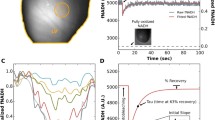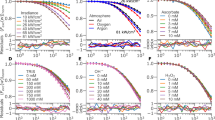Abstract
Direct observation of intracellular events and their relationship to physiological function presents a challenging and long-standing problem. The determination of intracellular oxygen levels in tissues has been a subject of continuous discussion, but most of the techniques for measuring oxygen tension in blood and tissue fail to indicate the oxidationreduction states of the respiratory carriers. Observations of the latter, however, would be of particular importance, since they reflect the intracellular level of energy transfering components. Reduced nicotinamide adenine dinucleotide (NADH) is one of the main means of energy transfer from the tricarboxylic acid cycle to the respiratory chain in the mitochondria. Most of the energy derived from aerobic metabolism is initially generated as NADH, which is oxidized to NAD+ as electrons are passed to the electron transport chain and, ultimately, to molecular oxygen. Decades ago, Chance and coworkers pioneered the fluorescence property of NADH as an indicator of the mitochondrial redox state and, in the presence of sufficient substrate and phosphate, as an indicator of cellular oxygen (Chance et al., 1962; Chance, 1976). For example, interruption of oxidative phosphorylation is associated with a prompt increase of tissue NADH levels, and that increase can be monitored by following its optical fluorescence (Chance and Schoener, 1965; Chance et al., 1965).The optical properties of NADH and NAD+ clearly differ in that upon ultraviolet excitation (330–390 nm), NADH, unlike NAD+, fluoresces in the blue (>430 nm). Meanwhile, NADH fluorescence measurements have been applied to single cells, cell suspensions, tissue slices, ex vivo perfused organs, but also to organs in vivo (Ince et al., 1992).
Access this chapter
Tax calculation will be finalised at checkout
Purchases are for personal use only
Preview
Unable to display preview. Download preview PDF.
Similar content being viewed by others
References
Chance, B., 1976, Pyridine nucleotide as an indicator of the oxygen requirements for energy-linked functions of mitochondria. Circ. Res. 38:131–138 (Suppl. 1)
Chance, B., and Schoener, B., 1965, A correlation of absorption and fluorescence changes in ischemia of the rat liver, in vivo. Biochem. Z. 341:340–345
Chance, B., Cohen, P., Jöbsis, F., and Schoener, B., 1962, Intracellular oxidation-reduction states in vivo. The microfluorometry of pyridine nucleotide gives a continuous measurement of the oxidation state. Science 137:499–508
Chance, B., Schoener, B., Krejci, K., Russmann, W., Wesemann, W., Schnitger, H., and Bücher, Th., 1965, Kinetics of fluorescence and metabolite changes in rat liver during a cycle of ischemia. Biochem. Z. 341:325–333
Ince, C., Coremans, J.M.C.C., and Bruining, H.A., 1992, In vivo NADH fluorescence. Adv. Exp. Med. Biol. 317:277–296
Suematsu, M., Oda, M., Suzuki, H., Kaneko, H., Watanabe, N., Furusho, T., Masushige, S., and Tsuchiya, M., 1993a, Intravital and electron microscopic observation of Ito cells in rat hepatic microcirculation. Microvasc. Res. 46:28–42
Suematsu, M., Suzuki, H., Ishii, H., and Tsuchiya, M., 1993b, Paradox of oxygen-radical-dependent cell injury in the hypoxic liver microcirculation. Prog. Appl. Microcirc. 19:127–138
Vollmar, B., Glasz, J., Leiderer, R., Post, S., and Menger, M.D., 1994a, Hepatic microcirculatory perfusion failure is a determinant of liver dysfunction in warm ischemia-reperfusion. Am. J. Pathol. 145:1421–1431
Vollmar, B., Lang, G., Menger, M.D. and Messmer K., 1994b, Hypertonic hydroxyethylstarch restores hepatic microvascular perfusion in hemorrhagic shock. Am. J. Physiol. 266:H1927–H1934
Vollmar, B., Rücker, M., and Menger, M.D., 1996, A new method for the intravital microscopic quantification of hepatic sinusoidal perfusion failure using the dye bisbenzamide H33342. Microvasc. Res. 51:250–259
Zeintl, H., Tompkins, W.R., Messsmer, K., and Intaglietta, M. 1986, Static and dynamic microcirculatory video image analysis applied to clinical investigations. Prog. Appl. Microcirc. 11:1–10
Author information
Authors and Affiliations
Editor information
Editors and Affiliations
Rights and permissions
Copyright information
© 1998 Springer Science+Business Media New York
About this chapter
Cite this chapter
Burkhardt, M., Vollmar, B., Menger, M.D. (1998). In Vivo Analysis of Hepatic NADH Fluorescence. In: Hudetz, A.G., Bruley, D.F. (eds) Oxygen Transport to Tissue XX. Advances in Experimental Medicine and Biology, vol 454. Springer, Boston, MA. https://doi.org/10.1007/978-1-4615-4863-8_10
Download citation
DOI: https://doi.org/10.1007/978-1-4615-4863-8_10
Publisher Name: Springer, Boston, MA
Print ISBN: 978-1-4613-7206-6
Online ISBN: 978-1-4615-4863-8
eBook Packages: Springer Book Archive




